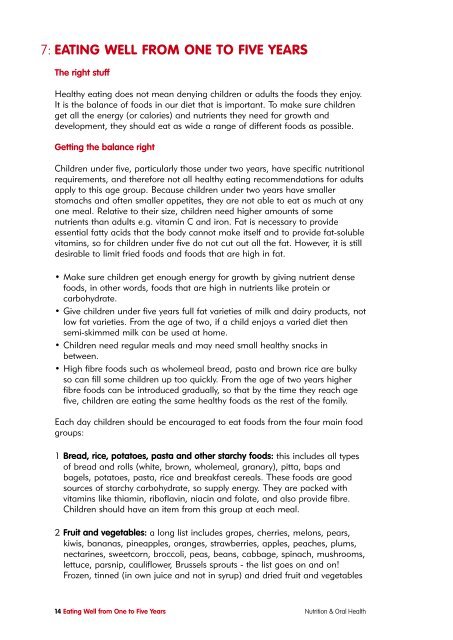Nutrition and Oral Health - NHS Lanarkshire
Nutrition and Oral Health - NHS Lanarkshire
Nutrition and Oral Health - NHS Lanarkshire
Create successful ePaper yourself
Turn your PDF publications into a flip-book with our unique Google optimized e-Paper software.
7: EATING WELL FROM ONE TO FIVE YEARS<br />
The right stuff<br />
<strong>Health</strong>y eating does not mean denying children or adults the foods they enjoy.<br />
It is the balance of foods in our diet that is important. To make sure children<br />
get all the energy (or calories) <strong>and</strong> nutrients they need for growth <strong>and</strong><br />
development, they should eat as wide a range of different foods as possible.<br />
Getting the balance right<br />
Children under five, particularly those under two years, have specific nutritional<br />
requirements, <strong>and</strong> therefore not all healthy eating recommendations for adults<br />
apply to this age group. Because children under two years have smaller<br />
stomachs <strong>and</strong> often smaller appetites, they are not able to eat as much at any<br />
one meal. Relative to their size, children need higher amounts of some<br />
nutrients than adults e.g. vitamin C <strong>and</strong> iron. Fat is necessary to provide<br />
essential fatty acids that the body cannot make itself <strong>and</strong> to provide fat-soluble<br />
vitamins, so for children under five do not cut out all the fat. However, it is still<br />
desirable to limit fried foods <strong>and</strong> foods that are high in fat.<br />
• Make sure children get enough energy for growth by giving nutrient dense<br />
foods, in other words, foods that are high in nutrients like protein or<br />
carbohydrate.<br />
• Give children under five years full fat varieties of milk <strong>and</strong> dairy products, not<br />
low fat varieties. From the age of two, if a child enjoys a varied diet then<br />
semi-skimmed milk can be used at home.<br />
• Children need regular meals <strong>and</strong> may need small healthy snacks in<br />
between.<br />
• High fibre foods such as wholemeal bread, pasta <strong>and</strong> brown rice are bulky<br />
so can fill some children up too quickly. From the age of two years higher<br />
fibre foods can be introduced gradually, so that by the time they reach age<br />
five, children are eating the same healthy foods as the rest of the family.<br />
Each day children should be encouraged to eat foods from the four main food<br />
groups:<br />
1 Bread, rice, potatoes, pasta <strong>and</strong> other starchy foods: this includes all types<br />
of bread <strong>and</strong> rolls (white, brown, wholemeal, granary), pitta, baps <strong>and</strong><br />
bagels, potatoes, pasta, rice <strong>and</strong> breakfast cereals. These foods are good<br />
sources of starchy carbohydrate, so supply energy. They are packed with<br />
vitamins like thiamin, riboflavin, niacin <strong>and</strong> folate, <strong>and</strong> also provide fibre.<br />
Children should have an item from this group at each meal.<br />
2 Fruit <strong>and</strong> vegetables: a long list includes grapes, cherries, melons, pears,<br />
kiwis, bananas, pineapples, oranges, strawberries, apples, peaches, plums,<br />
nectarines, sweetcorn, broccoli, peas, beans, cabbage, spinach, mushrooms,<br />
lettuce, parsnip, cauliflower, Brussels sprouts - the list goes on <strong>and</strong> on!<br />
Frozen, tinned (in own juice <strong>and</strong> not in syrup) <strong>and</strong> dried fruit <strong>and</strong> vegetables<br />
14 Eating Well from One to Five Years <strong>Nutrition</strong> & <strong>Oral</strong> <strong>Health</strong>

















